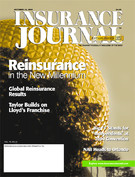Back in January 1998, when the market was emerging from a particularly difficult time, Max Taylor was elected to the position of Chairman of Lloyd’s of London. Now, the end of his term (in December 2000) is rapidly approaching.
In an exclusive interview with Insurance Journal, Taylor shared what he has learned during his three years at the helm of the 310-year-old insurance organization.
When he first took over, Taylor had an agenda for change designed to secure the future of Lloyd’s in a fast-changing world insurance market. “My initial philosophy was to keep a low profile, because there was a tendency for most of the press at that time to be pretty negative,” Taylor said. “We wanted to disappear for a bit, lay low, and go about our business.”
After working to resolve the problems of Lloyds’ past, Taylor’s approach was to focus on the customer—something that might sound easy, but actually required a fundamental reappraisal of Lloyds’ business practices. With the goal of expanding Lloyds’ position as the world leader in insurance, Taylor wanted to build on the franchise and make Lloyd’s more attractive to customers.
Even though it’s the oldest name in insurance, dating back to 1688, Lloyd’s of London is often described as “the best known but least understood brand in insurance,” Taylor said. “We’re convinced that there are lots more people who would like to do business with us—they know who we are, but they don’t quite know how to get to us.”
After researching the views of both customers and brokers, it was determined that a campaign was needed to ensure that the key audiences understood Lloyd’s and the benefits of being a marketplace, not a company. In January 2000, Lloyd’s launched its first ever planned ad campaign, initiating a six-month run of print advertisements in U.K. and U.S. financial and trade press.
“This [advertising] is something we had never done in the past, so to some extent it’s experimental,” Taylor said. “It’s part of our overall approach to raising our profile and making sure that people understand what Lloyd’s is all about.”
Although it is a very large organization, Lloyds’ structure of 120+ separate insurance syndicates competing for business also makes it very flexible. “Making ourselves more attractive to our customers is really about insuring that the market is a very easy, convenient and efficient place to do business,” Taylor said.
With that in mind, Taylor set out to ensure that Lloyd’s underwriters were able to compete on a level playing field. “We wanted to make sure our underwriters develop the tools they need to be the best they can be,” he said. “And that incorporates all sorts of areas, such as reducing overhead costs, working with the London market, dramatically improving service delivery/documentation delivery, and looking at new, emerging techniques for risk management.”
What does Lloyd’s mean to retail agents? “Our objective is primarily to be a dynamic market in London for major and complex risks, while at the same time to insure that we are well-positioned globally, perhaps for smaller business,” Taylor said.
And what does the U.S. market mean to Lloyd’s? “It’s our biggest market and it is currently our fastest growing market as well,” Taylor said, explaining that the U.S. is the largest overseas market for Lloyd’s underwriters, accounting for a third of Lloyds’ premium income in 1999. “It demonstrates that Lloyd’s as a marketplace seems to be extremely attractive, particularly when market conditions are a little more uncertain.”
Taylor said that he would like to think that they have brokers in the U.S. who always have access to Lloyd’s through wholesalers. “And our message is that if you don’t, than we’d like you to and we’ll find a way to put you in touch with the right people,” he explained.
Wendy Baker, president and director of distribution and development at Lloyd’s America Inc., helps out with this communication process by visiting regional brokers, wholesalers, surplus line associations, local RIMS groups and the like, making sure they all know how to access Lloyd’s.
“We’re really just trying to get out and talk to local and regional retail and wholesale brokers, to explain to them how Lloyd’s works,” Baker said. “So it’s sort of ‘Lloyd’s 101’—Hopefully from it and Lloyd’s syndicates we’ll get more business. But really, our focus is the education of producers.”
Although the Council of Lloyd’s invited Taylor to stand for a second term, he has expressed interest in continuing his career in a full-time, executive capacity, and therefore decided against standing again.
“I haven’t made any comments as to where I go from here, and it’s unlikely that I would do so before the end of the year,” he said. “I am fulfilling my obligation here at Lloyd’s. I’m very happy and I’m enjoying it thoroughly.”
Sax Riley, current deputy chairman of Lloyd’s and former chair of Sedgwick, will assume the role of chairman for a period of one year. “Sax is a lifelong Lloyd’s of London market guy, so he’s extremely well qualified,” Taylor said.
According to Taylor, the Lloyd’s market has responded to the many challenges faced by the insurance industry worldwide. “With the problems of the recent past behind us, and an impressive set of initiatives underway, I feel I leave the market in great shape for the future,” he concluded.
Was this article valuable?
Here are more articles you may enjoy.


 High-Net-Worth Risk Appetite Drops as Some Regions Show Stabilization
High-Net-Worth Risk Appetite Drops as Some Regions Show Stabilization  Severity Was Up, But Will Falling Claims Volume Impact the Profession?
Severity Was Up, But Will Falling Claims Volume Impact the Profession?  Longtime Motel 6 Spokesman Tom Bodett Settles Lawsuit Against Chain
Longtime Motel 6 Spokesman Tom Bodett Settles Lawsuit Against Chain  Kansas Man Sentenced to Probation for Insurance Fraud
Kansas Man Sentenced to Probation for Insurance Fraud 


